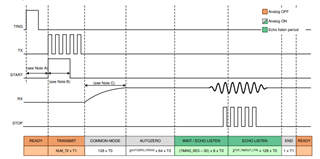Other Parts Discussed in Thread: TDC1000, PGA460, TUSS4470, MSP430FR6043
Tool/software:
Greetings,
I am trying to measure the TOF between 2 hydrophones with the TDC1000-C2000EVM using mode 1, I've removed R80 and R81 and I've connected the hydrophones on TX1 and RX1 respectively. Their resonant frequency is 125KHz, so I've changed capacitors C19 and C20 to 1nF capacitors. However, the TOF does not vary as a function of the separation distance between the hydrophones, and I even get a Stop pulse without having them connected.
I've also added 890 ohms before the RX1 input for resistive feedback as indicated in the datasheet.
What else should I do?
Thank you,


